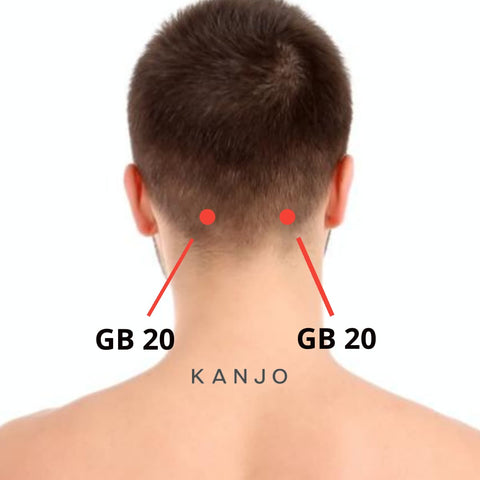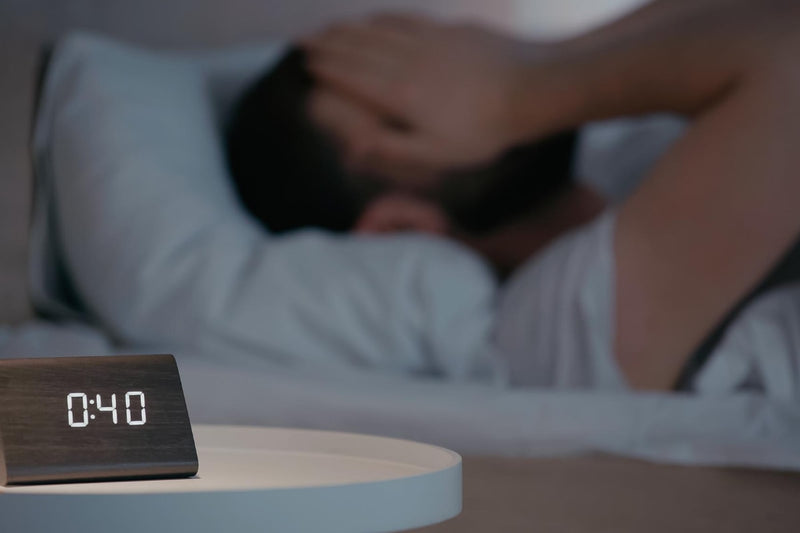The amount of sleep we get each night is not the only thing that matters. Sleep quality is another important factor that helps us feel well rested.
In fact, many people who suffer from insomnia often report feeling tired, even after sleeping soundly. Insomnia can be caused by a number of factors, including stress, anxiety and depression. It also may be related to certain medical conditions such as thyroid problems or Alzheimer's disease.
A healthy body requires adequate restorative sleep. However, most people aren't getting enough sleep. This may be due to poor sleep hygiene, stress, or a medical condition such as sleep apnea.

If you've tried everything else to solve your sleep problems, including prescription drugs, then you should try acupressure as an effective natural remedy instead. Acupressure is safe, effective, and won't cause any side effects.
This article covers the main pressure points for sleep and how to apply pressure for a better night's sleep.
11 Pressure Points for Sleep
Effective pressure points for sleep issues are those that have a calming effect and will help to relieve anxiety and stress.
There are a number of acupressure points for sleep that you can self-massage, but others where someone else can help you with.
To apply pressure and massage the points yourself, follow these steps:
- Place your thumb or 1-2 fingers on the pressure point. Common fingers to use are the index and middle fingers.
- Apply firm pressure on the pressure point and hold for 5 seconds. Take slow, deep breaths while applying pressure and massaging.
- Gently massage the point using a circular motion for 2 minutes.
- Repeat the pressure and circular massage on your other hand, arm, leg, or other body part.
1. Gallbladder 20 (GB 20) - Fengchi or Wind Pool

The GB 20 pressure points, also known as The Gates of Consciousness, are found where the top of the neck and base of the skull meet.
This pressure point helps to relieve insomnia, along with neck pain and stiffness, and headaches. It helps to calm your mind and reduce stress, allowing for a better sleep. It can also reduce coughing and other respiratory symptoms that will disrupt your sleep.
The best way to apply pressure to the Fengchi points yourself:
- Interlock your fingers and clasp your hands together with the palms facing you.
- Bring the cup shape over your head and rest your palm against the back of your head. Your thumbs will be free to apply pressure and massage the GB 20 points.
- You can alternatively massage up-and-down, instead of circular movements for these areas.
2. Governor Vessel 24.5 (GV 24.5) - Yintang or The Third Eye

The GV 24.5 pressure point is found between your eyebrows, where a Third Eye would be.
Applying pressure to this point will relieve anxiety-related symptoms like insomnia, restlessness, eyestrain, and sinus pressure pain.
3. Stomach 36 (ST 36) - Three Mile Point

The ST 36 acupressure point is found four finger widths below the bottom of the kneecap and one finger width to the outside of the shinbone.
This pressure point helps to relieve stress, nausea, knee pain, stomach pain, and other digestive issues.
4. Spleen 6 (SP 6) - Sanyinjiao

The SP 6 acupressure point is found 3 finger widths above the inside of the ankle.
This point will help to relieve insomnia, anxiety, and stress to calm the mind before going to bed. It will also help improve gastrointestinal and digestive conditions by influencing the lower abdomen and parasympathetic nervous systems.
5. Pericardium 6 (PC 6 or P 6) - Neiguan or Inner Frontier Gate

The PC 6 pressure point is located on the inside of your forearm 3 finger widths away from the wrist crease.
Applying pressure to this point will help relieve insomnia, anxiety, and nausea by calming the mind. It's well known for relieving symptoms of motion sickness.
6. Kidney 1 (KD 1) - Yongquan or Gushing Spring

The KD 1 acupressure point is found in the middle line of the foot sole. It's located one-third from your toes down the foot and two-thirds up from your heel.
Stimulating this point helps calm your mind, relieve headaches, nausea, and dizziness.
7. N-HN 54 - Anmian or Peaceful Sleep

The Peaceful Sleep common name already indicates that it will help give you a good night's sleep. It will help relieve insomnia and other sleep issues.
The Anmian points are found behind both ears at the base of the skull. It's in the soft area where the jaw line and neck muscles connect.
8. EX-HN 5 - Taiyang or Great Sun

The Taiyang pressure points are located on both of your temples. These points are often instinctively rubbed by those who are often stressed.
Stimulation to this point is often used to relieve pain like migraine and tension headaches, eye pain, and even toothaches.
9. Conception Vessel 17 (CV 17) - Chest Center

The CV 17 pressure point is found in the middle depression of your sternum. It's at the same horizontal level as the nipple.
Applying pressure and stimulating the point will relieve anxiety and stress. It helps with panic attacks, chest congestion and heart palpitations. It's often used to get rid of the stress accumulated through the day before going to sleep.
10. Heart 7 (HT 7) - Shenmen or Spirit Gate

The HT 7 acupressure point is located by following the pinkie finger down to a depression in the inner wrist crease.
Stimulating this point will help relieve insomnia, along with anxiety and stress. This point will also offer relief for irritability and chest palpitations.
11. Large Intestine 4 (LI 4) - Hegu

The LI 4 pressure point is located on the back of your hand in the groove that's between the thumb and index finger.
This point is commonly massaged for anxiety, headache, and neck pain relief. Stimulation will help put you more at ease before going to bed.
Does Acupressure for Sleep and Insomnia Really Work?
Acupressure has been used in Traditional Chinese Medicine (TCM) for thousands of years for insomnia and various sleep issues.
There haven't been many studies on the effectiveness of using acupressure for sleep and insomnia. However, the studies that have been done show promising results.
One study showed that stimulating the HT 7 point helped improve insomnia for two weeks after acupressure therapy for five weeks.
Another study saw sleep duration and quality improve after four weeks of acupressure to women with postmenopausal insomnia.
Even though there are a limited number of studies, they do suggest that acupressure may be an effective way to treat insomnia. At the least, there haven't been studies that had negative results, so it's worth trying.
When to See a Doctor for Insomnia
If acupressure and other natural methods are not working for you after 3-4 weeks, then it might be time to see a doctor.
They can help diagnose any underlying medical conditions that could be contributing to your sleep problems. They can also prescribe medications that may work better for you than herbal remedies.
Some doctors may recommend seeing a sleep specialist if you're having trouble sleeping. A sleep specialist can test your brain waves while you sleep to find out what's causing your insomnia.
You should also see a doctor if you are pregnant or have any other medical conditions. Your doctor can advise you whether or not you can safely use acupressure.
Pressure Points for Sleep Final Thoughts
If you're having trouble sleeping, whether it's because of stress, worry, or just plain old lack of restfulness, give acupressure a shot for relief.
You don't need to spend hours reading about all these different points. Just find the ones that work for you and apply pressure to those points before going to bed. You'll likely notice improvements after a few days.
But keep in mind that while acupressure therapy works well for some people, it may not work for others. If you're not sleeping any better with acupressure alone, then you might consider seeing a doctor.
Pressure Points for Sleep FAQs
Can you use acupressure to get kids or babies to sleep?
One of the best kid and baby pressure points for sleep is called the "Sleep Button." It's located between the eyebrows. Lightly stroking that point will help calm kids and babies down and put them into a relaxed state to help them sleep. Since baby skulls are still soft, it's best to use very light pressure.
Are there any risks to using acupressure for sleeping?
There are no major risks to using acupressure for sleep. The only risk is that if you accidentally press too hard, you can bruise yourself. But this isn't usually a problem since most people won't press too hard. If you are pregnant or have any medical conditions, talk to your doctor first about using acupressure.
Are there any tools that make it easier to press the points for sleep?
Acupressure tools can be used to more easily access and stimulate pressure points for sleep. Kanjo offers a variety of popular acupressure tools that will help:
- Acupressure Mat and Pillow Set
- Acupressure Foot Pain Relief Ball Set
- Flex Height Acupressure Neck Pain Relief Cushion

Sources:
- Healthline: https://www.healthline.com/health/pressure-points-for-sleep
- Medical News Today: https://www.medicalnewstoday.com/articles/327274
- Well and Good: https://www.wellandgood.com/pressure-points-for-sleep/
- Aculief: https://aculief.com/blogs/natural-healing/3-pressure-points-for-achieving-better-sleep
